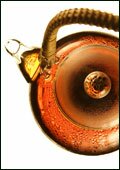Earl Grey Tea

Earl Grey tea is a taste, not necessarily a specific tea. While almost all Earl Grey teas were originally derived from black tea, today it can be a blend of Indian and Ceylon (Sri Lanka) tea, white tea, oolong tea, green tea or tisanes (teas made from flowers or roots, not of the tea plant). They can also come in organic form, a blend or herb tea. Earl Grey tea refers more to the bergamot oil that is used to flavor the tea then the tea base itself.
Bergamot oil comes from a small orange. It is said that Charles Grey, the second Earl and prime minister to King William IV, had a shipment of tea and bergamot oranges. Since tea naturally absorbs flavors, the tea took on the taste of the bergamot oranges, quickly becoming a favorite of Earl Charles Grey. Other stories have the Earl receiving a gifted recipe from a Chinese mandarin. The bergamot orange is actually a cross between the sweet or pear lemon and the Seville or sour orange which is native to Vietnam therefore giving the Chinese connection. Either way, Earl Charles Grey introduced us to what has become a world-wide favorite. Earl Grey tea has a slight tanginess, with a robust yet light refreshing flavor that leaves a delightful citrus aftertaste.
Perhaps because of the rich stories and folklore about how Earl Grey Tea originated, which are more than likely little more than marketing ploys, the tea has become used on the big screen. Some of the fictional characters that are said to enjoy Earl Grey Tea include James Bond 007, Bruce Wayne, Frasier, Captain Picard and even Piglet from the stories of Winnie the Pooh. Because of the attention Earl Grey tea has received, it quickly became a favorite in many different countries.
The oil of Bergamot has properties similar to grapefruit juices and can interfere with some medications. Since bergamot is rich in antioxidants, anemic individuals should not drink tea with meals as it blocks iron absorption. There are many health benefits from the oil of bergamot. It is known for treating fevers, intestinal worms and controlling anxiety. It is also notable that bergamot is a disinfectant and an anti-depressant. Bergamot helps to fight the flu and colds. Bergamot contains esters and alcohol in small amounts which may assist in sleep though the caffeine in the tea, if the base is from a tea plant, may counteract this effect. The fluoride found in black tea may help to fight tooth decay but on the other hand tea can cause staining of the teeth.
Most people drink Earl Grey tea because of the soothing and delightful taste rather than the health benefits that it may have. Earl Grey tea is widely available around the world and has become rather popular in the twentieth century. As with any tea, purchasing loose leaf Earl Grey tea will maximize the taste and intensify your tea tasting experience. Many fine-dining restaurants serve Earl Grey tea therefore one is able to find this tasty delight in more places than just the large retailers and gourmet shops.
Disclaimer: The information contained on this site is not intended to replace the diagnosis, treatment, consultation and services of a qualified Medical Practitioner. All information presented is in summary form and intended only for informational purposes. Always seek immediate medical attention for any illness you may have and never disregard the advice from qualified Medical Practitioners as something you have read on this site (or related sites) could be misinterpreted.

